Christmas, Frankenstein, throne and other symbols of the movie Alien: Covenant (2017). The plot and meaning of Alien: Covenant was considered weak and stupid by many disappointed fans of the franchise about deadly alien creatures and ordinary viewers. Of course, not without reason – there are a lot of reasons, from the reckless behavior of the characters to the seemingly completely unjustified abundance of religious references. However, Alien: Covenant is just the case when the elements of the picture that irritate the audience are not at all plot blunders or empty pretentious inserts, but are part of a really deep author’s intention.
Country : USA, UK
Genre : Fantasy, Action, Horror
Year of production : 2017
Director : Ridley Scott
Cast : Michael Fassbender, Katherine Waterston, Danny McBride, Demian Bichir, Billy Crudal
tagline : “Run”
Awards and Nominations : Nominated for the Saturn Award for Best Science Fiction Film in 2018.
Prometheus and other parts of the franchise
Alien: Covenant is both a direct sequel to 2012’s Prometheus and a prequel to 1979’s Alien. In addition to these pictures, to describe the Ridley Scott universe, one should keep in mind promotional videos for Prometheus (which, for example, includes a speech by a young Peter Weiland) and five short films, united by the name of the main film with subtitles: Phobos, Meet Walter, The Last Supper ”, “Connecting Link” and “Coming”.
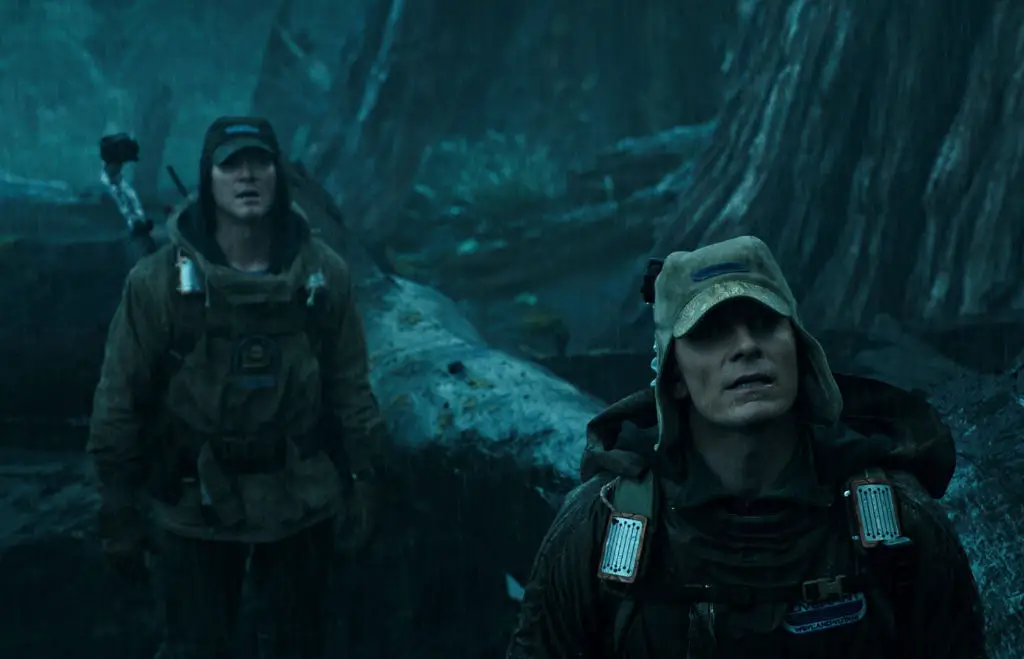 Frame from the film.
Frame from the film.But all the continuations of the first “Alien” (the second, third and fourth parts), the “Aliens vs. Predator” crossovers, as well as comics, books and games dedicated to deadly xenomorphs, were not taken into account by the director. So their content can be very different from the creation of Ridley Scott. Even the official novelization (of the book) of Alien: Covenant contradicts the movie in many ways.
Plot Analysis of Alien: Covenant
Alien: Covenant begins with a conversation between Weyland Corporation CEO Peter Weiland and his android creation. The latter chooses the name “David” for himself by looking at the statue of “David” by Michelangelo standing in the room. The android is playing Wagner’s “Entry of the Gods into Valhalla” on the piano, but pauses to ask a question. He asks Peter, “If you created me, who created you?”. He replies that together with David he will find the answer to this question. At the same time, Weiland says that he refuses to believe in the theory of evolution – the birth of a person cannot be an accident.
David notices that he already sees his creator in front of him and understands his superiority over him: a person is mortal, but an android is not. Weiland is visibly annoyed. Instead of answering, he orders tea to be served to him. Synthetic obeys.
We are transported to the year 2104. Eleven years have passed since the death of the Prometheus expedition. The Covenant spaceship flies to the planet Origai-6. On board are fifteen crew members, two thousand colonists and one thousand one hundred and forty human embryos. All of them are in cryosleep. The android Walter, outwardly a copy of David, is on duty. As a result of a neutrino explosion, the ship is damaged. Walter urgently brings the crew out of suspended animation, but some of the people die in their cryocapsules. Among the dead is the captain of the ship, Jake Branson, who is the husband of the main character Daniels. She takes the loss hard.
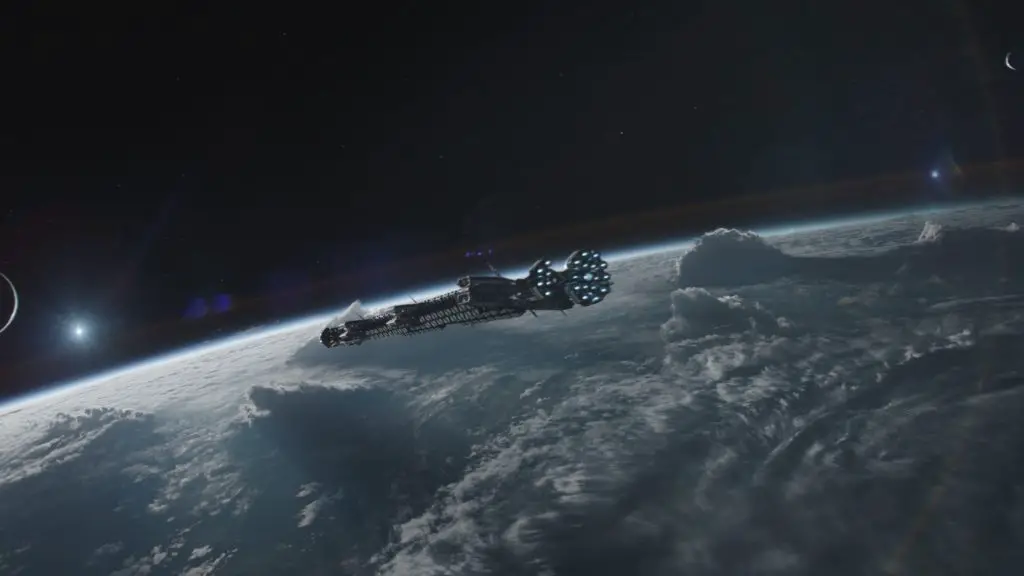 Frame from the film.
Frame from the film.Command is taken by Deputy Captain Oram. During the repair of the ship, one of the crew members receives a signal in the form of the song “Take Me Home, Country Roads” by the American bard John Denver. It comes from a planet that, according to scans, is more habitable than Origai-6, and is also much closer. Oram decides to send the ship there. Daniels tries to challenge him, but in vain.
The ship arrives at a new destination. Most of the crew is sent on a landing shuttle to the surface of the planet. There is a lot of vegetation and there is even terrestrial wheat, but animals are completely absent. The team is divided: some collect samples for research, others go to look for the source of the signal in the mountains. The latter discover the destroyed ship of the “engineers” race – the same one that flew Dr. Elizabeth Shaw and android David after the failure of the Prometheus mission. It turns out that Elizabeth created the signal in the form of a song received by the Covenant team.
In each group, one of the crew members becomes infected with some organisms that look like fungal spores. Both become ill, they die: pale neomorphic creatures break out of their bodies. While defending himself against one of them, Faris’ pilot hits a gas tank with a shotgun, causing the dropship to be destroyed. As a result of incidents with neomorphs, several crew members die.
Part of the second group is rescued by David who suddenly appears. He takes people to an ancient city full of dead representatives of the “engineers” race. David says that he flew here with Elizabeth Shaw, but she died on landing.
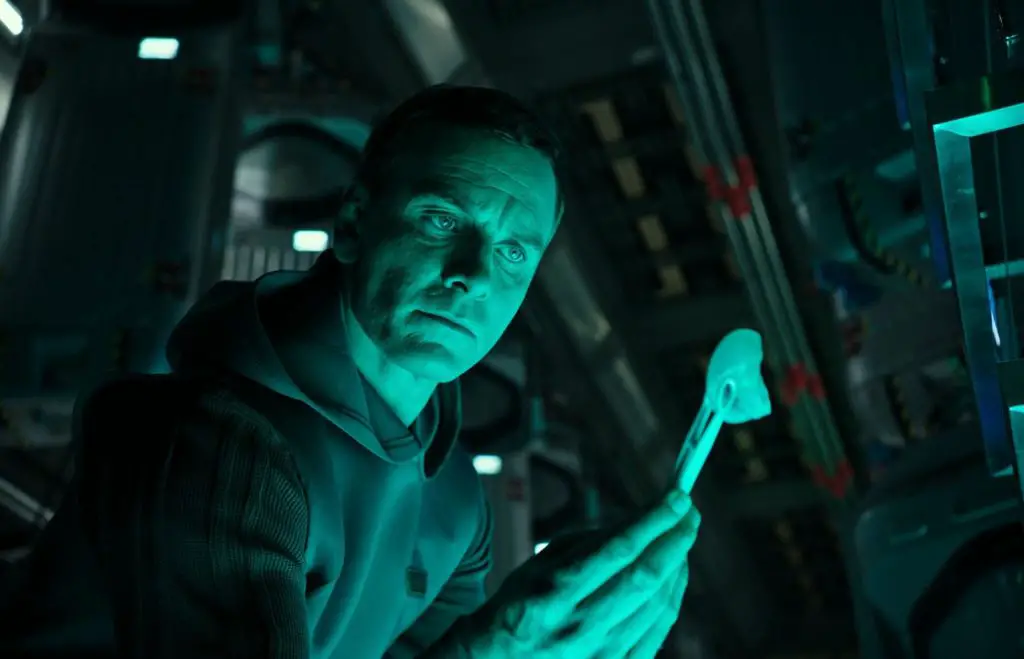 Michael Fassbender played the role of David. Frame from the film.
Michael Fassbender played the role of David. Frame from the film.The android communicates with its fellow Walter, starting the conversation with a quote from James Montagu’s “You whistle – I won’t keep you waiting.” He teaches him to play the flute and talks about their common creator, Peter Weiland. David calls Weyland a man unworthy of his creation. Walter says that he is a new model of android, more attentive and efficient, but with less human qualities. David notices that, among other things, his brother is not allowed to create.
Admiring the view from his dwelling, David recites the sonnet “Ozymandias” to Walter. We are shown the moment of arrival of the android on the planet of “engineers”. He dropped urns with black goo on the city, as a result of which all the inhabitants of the city became infected and died. David shows Walter the grave of Elizabeth Shaw and says that the girl was very kind to him and he loved her.
Another member of the team falls victim to the neomorph. Oram also dies. David lured him into his “workshop of the devil”, where he performed genetic experiments, and showed him the Alien eggs. Facehugger burst out of one of them and paralyzed Oram. Soon a xenomorph emerges from his chest. David treats him like his own child.
Walter discovers the corpse of Elizabeth Shaw, from which the insides are extracted, and guesses that David destroyed the local civilization. Androids argue with each other. David says humans are an endangered species that doesn’t deserve a second chance. Walter objects, because people created them. David considers himself a new prophet. Walter asks him who wrote Ozymandias. The android answers: Byron. Actually the author is Shelley. David confesses his love to Walter, kisses him, and then delivers a paralyzing blow.
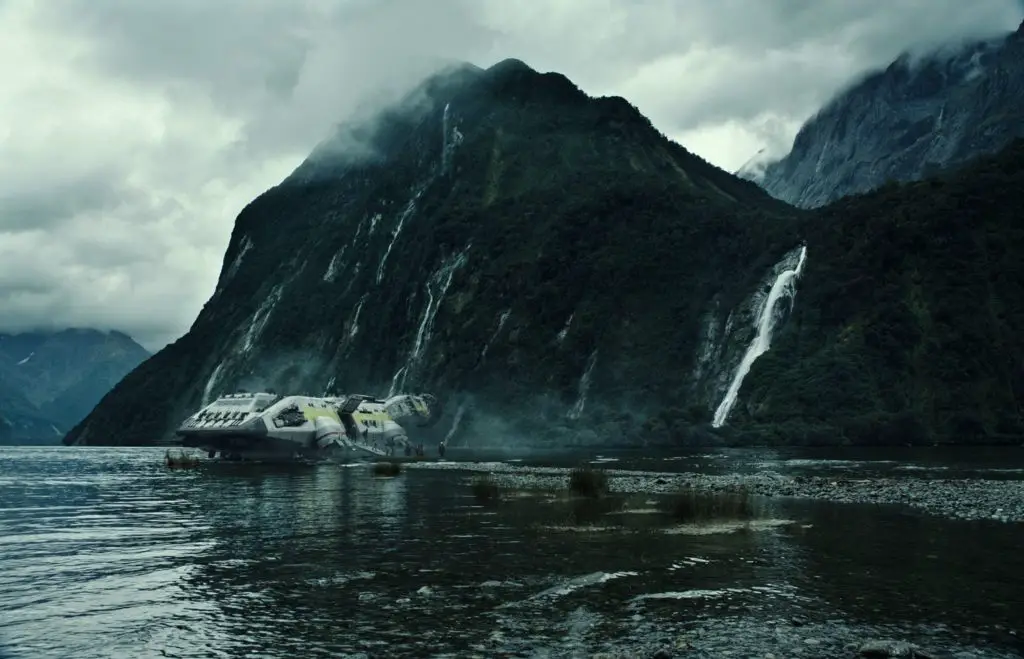 Frame from the film.
Frame from the film.The crew members encounter a xenomorph and continue to suffer casualties. Meanwhile, Daniels finds scrolls containing numerous scary paintings of David. The latter immediately appears and attacks the girl. He grabs her and kisses her. The revived Walter interferes with his colleague. Androids fight. Walter wins, but the final battle remains off-screen.
The Tennessee crew member, who has taken control of the ship in Oram’s absence, descends to the planet on a cargo platform and takes on board the surviving Daniels and Lope, as well as one of the androids, who is mistaken for Walter.
The survivors continue their flight to Origami-6, but a xenomorph breaks out of Lope’s chest (he was previously attacked by a “face-hugger”, which his partner helped get rid of) and kills two more crew members. Daniels and Tennessee, with the help of an android, manage to throw an “alien” into space.
Before diving, Daniels asks the android if he can help her build the house on the lake that her dead husband dreamed about. Indeed, before landing on the ill-fated planet, Walter talked with the heroine about this dream. But android doesn’t understand the question. Daniels realizes that it is probably David in front of her. However, it’s too late: the girl falls asleep in the capsule. Left alone on the ship, the android uses David’s password and asks the onboard computer to turn on Wagner’s “Entrance of the Gods to Valhalla”.
He places face-hugging embryos next to the human embryos. The android, on Walter’s behalf, writes in the logbook that all of the crew except Daniels and Tennessee died in the neutrino blast.
Answers & questions
So, many details of the plot seemed stupid or completely meaningless to the audience. Let’s try to give them an explanation and answer the questions that arose during the viewing.
Did David really create xenomorphs? And how exactly did he do it?
Yes. Xenomorphs are the work of David. This is confirmed in an interview with the director himself. However, according to Ridley Scott, he is much more interested in the motives that drive the android when creating “strangers” than the process itself. Therefore, the latter is taken out in a separate short film “The Coming”, and is also detailed in the book “Alien: Covenant. David’s Drawings, made in the form of a voluminous android art report and released simultaneously with the release of the film. The artists created the illustrations under the strict supervision of Ridley Scott. They were also used in the design of David’s laboratory in the film.
The android’s experiences, according to the book, were complex and lengthy. He prepared the soil of the planet, fertilized it, harvested, created a cocoon and nourished it, selected “successful” mutations for further research. Trying to bring out an organism that was perfect from his point of view, David carried out this scheme many times.
The basic elements of all the android’s terrible experiments were the black goo obtained during the mission on the planet LV-223 in the prequel. It is used to breed the “engineers” race. The scheme is this:
- The male takes a drop of black goo inside and copulates with the female.
- The spermatozoon of the male individual is transformed, leaves the womb of the female individual and infects the third individual, the presence of sexual characteristics in which is no longer necessary.
- From the third individual emerges a being called a “deacon”.
- The blood of the “deacon”, similar to black goo, but with a golden hue, is drunk by another individual.
- Having drunk the blood of the “deacon”, the individual also dies, but populates the planet with its children.
Parts of this process were shown in Prometheus. And this is exactly what the “engineers” did in their “temple”. By and large, its meaning is to saturate and transform the black liquid. Without these manipulations, it is dangerous in itself, but does not carry reproductive value. But David’s goal was precisely the creation of a new life. That is, he had to largely repeat the experience of the “engineers” and grow a full-fledged complex organism from the “virus”, and even take care of its survival.
 The role of Daniels was played by Katherine Waterston. Frame from the film.
The role of Daniels was played by Katherine Waterston. Frame from the film.In David’s memory, we saw that he infected the population of the city with black goo. How did he do it? The fact is that in each urn there is not just black goo, but, as was shown in Prometheus, four flasks with it and a gel-like substance that binds them. If you extract the contents of the flasks and add this substance, then the result will be a primitive multicellular organism. In the script for Alien: Covenant, he is called “algae”. When an organism comes into contact with a creature, it fertilizes cell by cell, breaking down the flesh and forming this “algae” (the process was shown in David’s flashback), which is the first element to build a cocoon.
Another element is mutated mushroom spores, which are the prototype of the “face-hugger” and look like it in appearance (the designers who worked on the graphics claim that this is so). The third element is the womb of the female. For him, David used the insides of Elizabeth Shaw.
In the book “Alien: Covenant. David’s Drawings” describes all of David’s terrible “work”, starting with his painstaking studies of the flora and fauna of the planet “engineers”. It shows that the android did not come to the combination of these three elements immediately. One of the first experiences of the birth of a new creature was the use of mutated spores (similarly, the crew members of the Covenant who inhaled them “gave birth” to neomorphs: the spores are carried through the blood, which is why the monster comes out of a random part of the body).
But this did not suit David, and the “work” continued. Each new experiment was accompanied by the addition of new genetic material to the previous one. As “additives” David used the animals of the planet and the “engineers” themselves, both survivors of his “bombing” and reanimated. Successful and unsuccessful mutations were listed in the “catalogue”.
As a result, the last version of the cocoon with the “face-grab” is a kind of constructor based on black goo and the diverse genetic material of the inhabitants of the “engineers” planet. However, from David’s point of view, it was not final either. The android was going to continue the experiments, using no longer “engineers”, but people, which is shown at the end of the movie “Alien: Covenant”.
By the way, the cocoons in the 1979 film were made from the remains of the bodies of the crew members, as shown in the cut scene.
 Billy Crudup as Christopher Oram. Frame from the film.
Billy Crudup as Christopher Oram. Frame from the film.But what about the image of “alien” on the wall of the “temple” in “Prometheus”?
It does not depict the final version of the xenomorph created by David, but the “deacon”. The latter is part of the reproductive process of the “engineers” and the appearance of a fresco with it is fully justified.
But what about the “alien” queen (the queen) that lays her eggs in the second part of the franchise, filmed by James Cameron?
Here we recall that the second and subsequent “Aliens” are, as Ridley Scott himself said, already a completely different cinematic universe. For James Cameron, “strangers” are like an ant colony. For Ridley Scott, they are more like a cancer.
But what about the “engineer” ship with “alien” eggs on board, discovered by members of the Nostromo crew in the 1979 film?
Fans of films about xenomorphs expected from the picture “Alien: Covenant” the solution to what happened to the “engineer”, his story. It is clear that they associated the planet Eden (or Paradise) shown in the last film with LV-426, on which the Nostromo landed. But there is no data to consider these planets identical. Of course, the catastrophe that happened to the ship of the “engineer” is a consequence of David’s experiments, since the eggs of the “strangers” were invented by him. But we don’t know how it happened. All this was to be explained in the sequel to Alien: Covenant, which was going to be directed by Ridley Scott. But, alas, the studio “20th Century Fox” was disappointed with the box office of the last picture and did not give the green light to the sequel.
There is a theory that “LV – 426” is the same planet “Origae – 6”, where the “Covenant” ship was originally sent and eventually went. The fans made such an analysis of the name of the latter: “Orig” (4 letters), “AE” (2 letters) and actually “6” – “426”. Further: “Orig” is “Original”, “AE” is “Alien Encounter”. It turns out “Original Alien Encounter”, which can be translated as “Meeting with the original” alien “.
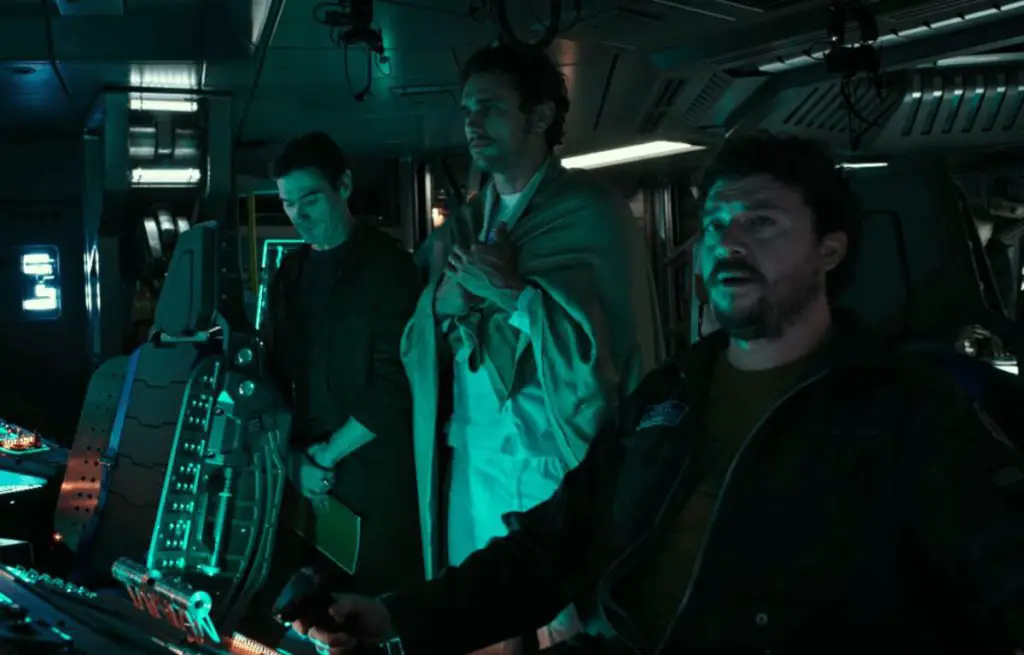 Frame from the film.
Frame from the film.Why do the “engineers” who meet the ship in a city on the planet Paradise look like the inhabitants of a medieval human settlement without a single hint of high technology?
The planet is named so for a reason. In biblical myth, God lived in paradise with his creatures in perfect harmony. However, she came to an end after the violation of the ban on the fruits from the tree of knowledge. On the planet “Paradise” “engineers”-creators live together with “engineers”-creatures. The latter treat the former with reverence, probably pray to them and build temples in their honor. The idyll will be dispelled if the forbidden fruit is plucked, that is, if ordinary people dare to touch the secrets of their creators, master their technologies. Let us recall the speech of Peter Weiland before the flights of Prometheus: the difference between the gods and mere mortals is the presence of the “fire of Prometheus”.
According to the mythology invented by Ridley Scott, people on Earth were once the same, their development was under the control of the “gods”. But two thousand years ago, something happened (wars, moral decline) that forced the “engineers” to try to intervene and restart evolution, having previously destroyed most of humanity. The last straw was the crucifixion of Christ, sent by them. This is hinted at in a cut scene in Prometheus. In it, before a surge of rage, the “engineer” talks with Elizabeth Shaw. The humanoid explains why he was going to destroy humanity. He even calls the Earth a new Eden.
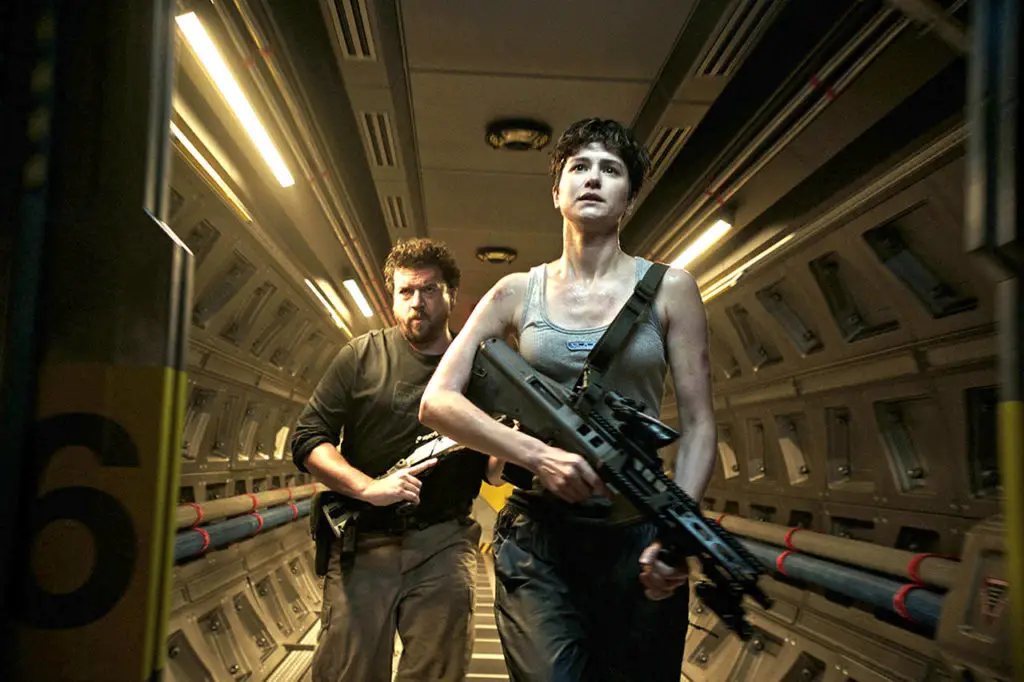 Danny McBride as Tennessee, Katherine Waterston as Daniels. Frame from the film.
Danny McBride as Tennessee, Katherine Waterston as Daniels. Frame from the film.Why are the crews of the Covenant and Prometheus behaving so recklessly, not to say “stupidly”?
“Covenant” – in general, the first colonial mission! Here should be the most intelligent, dexterous and courageous representatives of mankind!
This is not a plot blunder at all or an attempt to go down the path of low-grade slashers, where the heroes become victims due to their often frankly stupid decisions. It seems that the director deliberately shows the characters in such a way that the viewer would like to shout: “Stop! What are you doing? Are you immortal?” Indeed, the characters almost stick their hands in everything. They literally feel immortal and behave accordingly.
The secret is that in the world shown by Ridley Scott, humanity has long mastered advanced technologies and has come close to the “gods”. Most diseases, even cancer, have been defeated (again, we recall Weiland’s speech), space is being successfully mastered. Probably no one has yet faced an insurmountable danger such as xenomorphs. Everything that astronauts do has been done hundreds of times before. They do not have any means of biological or chemical protection. Weapons generally do not appear to have been modernized since the twentieth century. There was simply no need for either.
People have total trust in technology. If an android says something, then you need to believe him. Oram, even after the incident with the neomorph, let David lead him into a trap. This android in general seems to be unique. On Earth, his brethren, although there were complaints (thanks to which they were improved and created models like Walter), it was unlikely that it came to murder. In the short film The Last Supper, a choked crew member was rescued by an android, while the rest just stood and watched, unable to do anything.
If the scanner shows that the atmosphere is harmless and suitable for breathing (the voice of the on-board computer before entering the surface of Paradise or the readings of the instrument in the pyramid on LV-223), then they will also believe it unconditionally. In fact, even if we are talking about our non-cinematic universe, the probability of getting infected on an alien planet for people tends to zero (not to mention, of course, such specific things as, for example, radiation). Even on Earth, the estimated number of species of microbes reaches a trillion, of which only about ten thousand cause diseases, that is, only 0.000000001%. And even these pathogens have adapted to the human body in the course of a long evolution. On planets where there are no people, they have practically nowhere to come from.
 Frame from the film.
Frame from the film.And “Covenant” is not the first colonial mission! There is not a single, even indirect, evidence in the film that such an adventure is carried out for the first time. Critics rely on Daniels’ words in the prologue: “This is the first large-scale colonization mission …”. But this phrase has a continuation: “… in such (!) remote corners of the galaxy.” That is, this has already happened, but on a smaller scale. So, in The Last Supper, one of the crew members mentions some creatures that look like cockroaches, but the size of a poodle, living next to the colonial post. It can also be understood from the conversation that the “Covenant” did not start from the Earth, but from another planet inhabited by people. That is, the colonization and discovery of life in space for these astronauts is not at all uncommon.
Another important detail: many crew members, both in Prometheus and in Alien: Covenant, acted contrary to logic, but relying on faith. Both Elizabeth Shaw and Peter Weiland believed in the “engineers” who created people – after all, the evidence given by archaeologists can hardly be called convincing. Oram, who took over as captain of the Covenant, was deeply religious. And the turn to Paradise instead of continuing the path to Origai-6 was largely due to this. For Oram, the sudden appearance of a habitable planet was, in fact, a sign from above. And following it made more sense to the believer than following a set course. In a dispute with the main character, Oram even says: “I’m not extreme,” meaning that he acts reasonably and is not inclined to challenge fate, unlike Daniels herself, who was engaged in rock climbing with her husband. AND,
 Goran D’Clue played the role of the Xenomorph. Frame from the film.
Goran D’Clue played the role of the Xenomorph. Frame from the film.Symbols
Before revealing the essence of the film “Alien: Covenant” let’s look at some of its symbols. Thanks to them, much will already become clear.
In the very first scene where David is talking to Peter Weiland, we see several objects: Piero della Francesco’s “Nativity”, Michelangelo’s “David” statue, Carlo Bugatti’s chair, Steinway piano. What is the symbolism here? First of all, these items are one of the best examples of human creativity, just like the android.
The painting “Christmas” is dedicated to the birth of a special person, which hints at some kind of chosenness of David. This special Jesus Christ, the son of God and the messiah, and according to the mythology of the film, the son and representative of the “engineers”.
The future King of Judea and Israel, David, depicted by Michelangelo, is a character from the Old Testament of the Bible. It focuses on the upcoming battle with the giant Goliath (there may be an association with the giants-“engineers”). Victory awaits him. The android takes the name of this majestic character.
The unusual chair of Carlo Bugatti is very reminiscent of the throne of a warlike king.
On the “Steinway” piano, David plays “Entrance of the Gods into Valhalla”. The same music will be played at the end of the film. This is the ending of the opera “Rheingold Gold”. By this point, according to the plot of the work, the gods rejected people who were considered cruel, greedy and weak, and went to their heavenly chamber. Their procession is rather tragic than solemn. After all, they are the same as the people they rejected, and an unenviable fate awaits them. Both Prometheus and Alien: Covenant are about “engineers”, humans and an android who imagine themselves to be gods, but will certainly be (or already) destroyed by their own creations. The music of the German composer Wagner, the creator of the Rhine Gold, inspired the Nazis, he himself was an anti-Semite. David is also engaged in the selection of ideal and the destruction of creatures that are imperfect from his point of view – in fact, he will become a fascist.
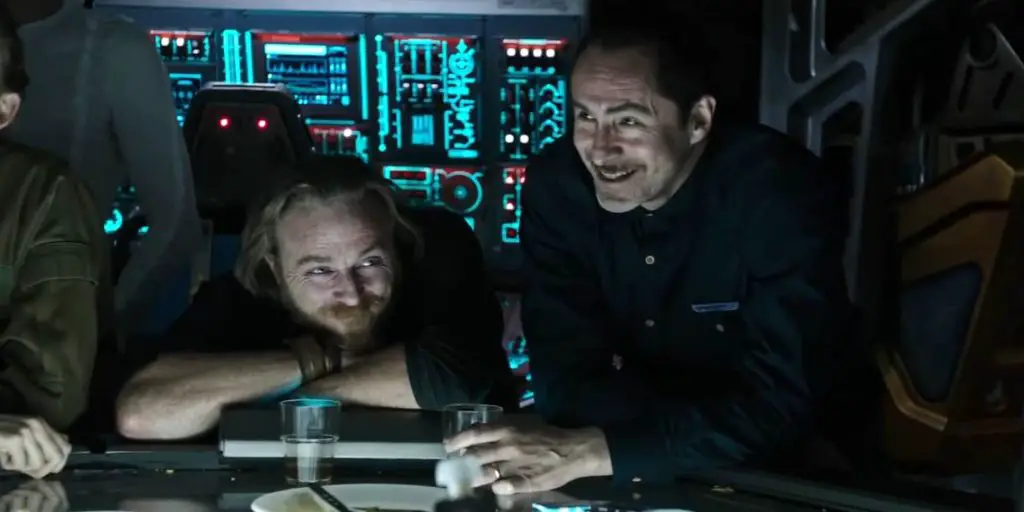 Demian Bichir played the role of Lope, Nathaniel Dean played the role of Hallet. Frame from the film.
Demian Bichir played the role of Lope, Nathaniel Dean played the role of Hallet. Frame from the film.David begins his conversation with Walter with a quote from James Montagu’s “You whistle – I won’t keep you waiting.” The hero of the story, a young scientist, finds a whistle that once belonged to the Templars (a Christian spiritual and knightly order), and summons a terrible ghost.
From David’s dwelling in the rocks closer to the junction, a view reminiscent of Arnold Böcklin’s painting “Isle of the Dead”, which Adolf Hitler really liked, opens up. She was even in his collection. Well, and, of course, the planet Paradise after the appearance of David on it became a real “island of the dead.” Böcklin’s paintings were loved and used in his work by Hans Rudi Giger, who originally came up with the image of “alien” for the 1979 film. By the way, the image of the gutted body of Elizabeth Shaw in the film is an homage to the portrait of Giger’s muse and mistress Lee Tobler.
Admiring the landscape of the “Isle of the Dead”, David reads out an excerpt from the sonnet “Ozymandias”. He considers Byron to be the author of the work, although in fact it is Shelley. The first captivated readers with his “gloomy selfishness.” The second is also the author of the novel Frankenstein, or the Modern Prometheus. In it, the scientist comprehended the secret of the origin of life and learned to revive matter. As a result of the experiments, a monster appears, which people hate for its ugliness, and which, with the aim of revenge, begins to pursue its creator. Both Prometheus and Alien: Covenant reference this work in many ways.
Why is David’s mistake introduced into the plot of the film? Why, according to Walter, is this the note that ruins the whole piece? Perhaps the point is to emphasize: David considers himself one of the Byronists, who are characterized by disappointment in human society, world sorrow and the cult of the superman. In fact, he is angry and offended by his creator Frankenstein.
The sonnet “Ozymandias” itself is dedicated to the half-buried remains of the statue of the pharaoh and contrasts the proud words of the ruler with his impartial image. David is the same pharaoh, in thoughts and words striving for greatness, but in fact a monster that brings death.
 Frame from the film.
Frame from the film.The meaning of the film Alien: Covenant
Alien: Covenant is a direct sequel to Prometheus . Both films carry the same idea of conflict between the creator and his creation.
In Prometheus, Peter Weiland imagined himself equal to the “gods” – “engineers”. Still would! He is the head of a powerful corporation in whose hands are the most advanced technologies. Weyland considered that he had the right to ask even for immortality. Such impudence deeply offended the “engineer”: not even the request itself, but the fact that the despicable person dared to create his own kind – an android.
“Alien: Covenant” is dedicated to David (according to the accents, he is rather the main character, not Daniels), who despises his creators – both the direct creator of Weiland and the progenitors of humanity “engineers”. The feeling of own superiority, disguised as a perverse craving for beauty, pushes him to the top – to the symbolic Olympus, which is the planet Paradise.
In fact, both the “engineers” and the crazy android are a reflection of the image of modern man. We master technology with pride and think that it makes us the crown of creation. We are moving further and further away from our nature. Surrogates appear in our lives – substitutes. “Engineers” this led to the fact that even the natural process of reproduction turned into a terrible perverted ritual, and the humanoids themselves lost their sexual characteristics. People in Ridley Scott’s universe are moving inexorably in the same direction. In this world, there is no longer natural childbirth – there is the cultivation of embryos with the help of machines, and sexual relations are becoming more and more free (in all three films, as well as in cut scenes and short films, there are hints of this).
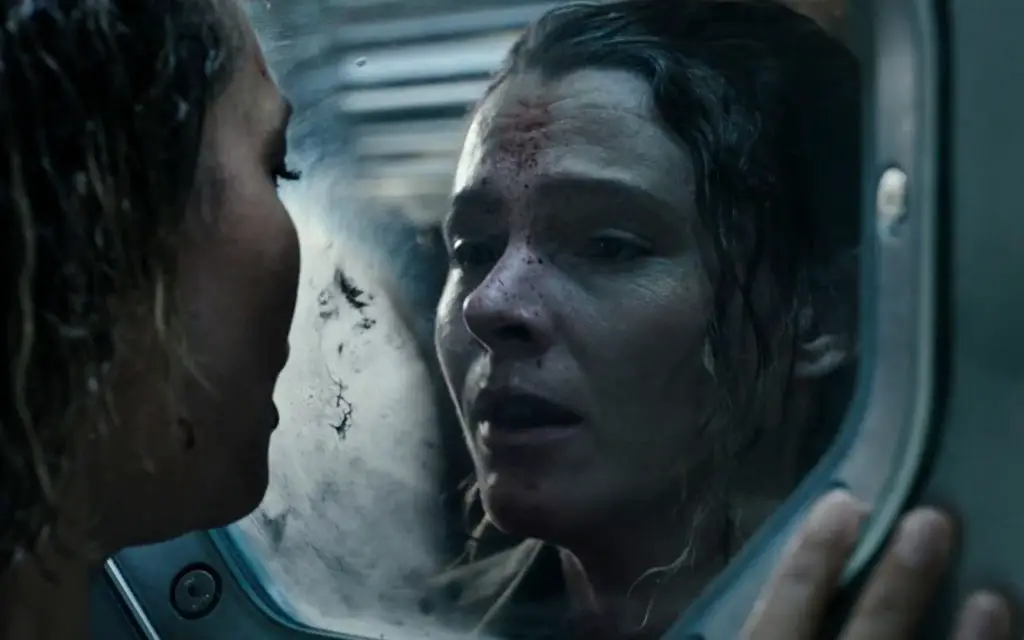 Carmen Ejogo as Karin, Amy Seimetz as Faris. Frame from the film.
Carmen Ejogo as Karin, Amy Seimetz as Faris. Frame from the film.David selflessly and scrupulously creates a perfect creature, without even realizing that he is giving birth to real monsters. He longs to create life, but brings death. This desire is reflected both on the spiritual level (perverted works of art) and on the physical level – on the sexual level. It’s not just that David’s kiss to Walter and the android’s attempt to rape Daniels are shown. He has no genitals and, in fact, this behavior is a kind of sublimation (remember the 1979 movie and Ash’s android trying to put an erotic magazine in Ripley’s mouth).
David claims to be capable of true love, but subjects his “beloved” Elizabeth Shaw to real torture. In an effort to comprehend the beautiful, the android turns into a cruel maniac killer.
The worst thing is that David really wanted to respond to Elizabeth’s kindness and care, but he himself, deprived of these qualities, simply could not do it. This is yet another warning of what we humans have to lose due to advances in technology.
All this is just part of the hidden meaning laid down by the director. Interpretations can be different depending on what part of the plot of the work we take. For example, the confrontation between David and Walter is similar to the confrontation between an independent creator and a limited artisan. Surely Ridley Scott draws a parallel with his inner subpersonalities: one is eager to create despite the restrictions, the other is forced to obey the will of producers and viewers.
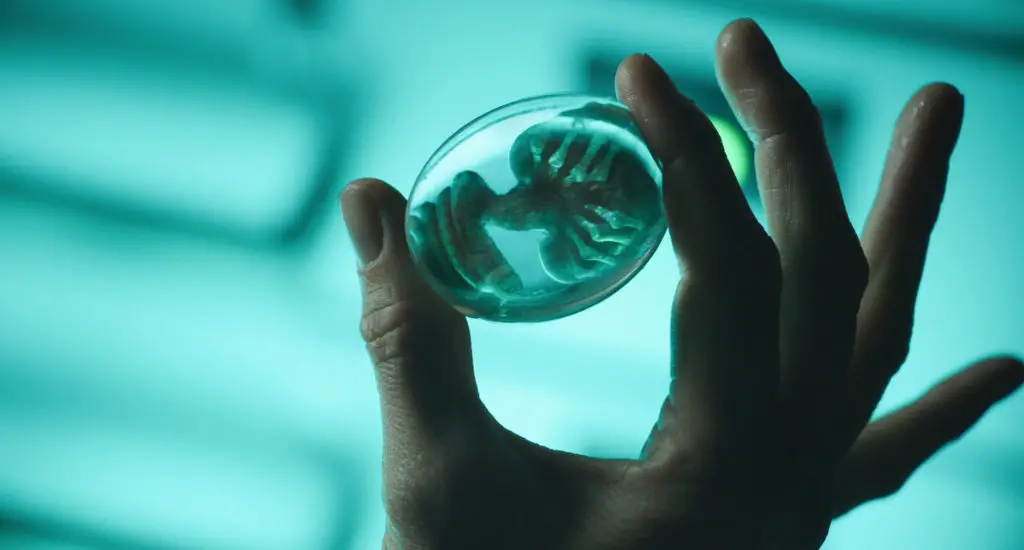 Frame from the film.
Frame from the film.If you look for the main idea embedded in the film, it is enough to analyze what happened in it. And this is what happened: representatives of humanity, embraced by technology with faith in their own invulnerability and greatness, became a victim of their own offspring. A stronger (in the broad sense) individual destroyed the weaker ones – their own creators.
Unfortunately, Ridley Scott felt that further clarification was unnecessary. Because of this, the viewer gets a completely different picture: the narrow-minded representatives of humanity became victims of their own amazing stupidity.
Alien: Covenant Ending explanation
Many viewers scold the director for the final twist, which was obvious from the very beginning. Indeed, knowing that David and Walter were the same person, it was clear that the former would at some point take the place of the latter.
However, this interpretation of the meaning of the ending of the film “Alien: Covenant” does not suit everyone. There are several significant inconsistencies. For example, how was David able to replace his hand with Walter’s injured hand so quickly? And why did he have to imitate a scar on his face, received during a fight, which was not a witness to any of the crew members? But for some reason, David does not have the scar that he received as a result of the fight with Daniels (hit with a nail in the chin). There is no damage to the vocal apparatus from Walter’s blow.
On the other hand, the android in the finale used David’s access code, so this is David after all? Yes and no. Probably, the director wanted to show that Walter was still seduced by David and the androids merged together. Perhaps the first gave his synthetic shell to the second. In other words, the explanation for the ending is that Walter’s body appears before us at the end, “absorbing” David’s consciousness.
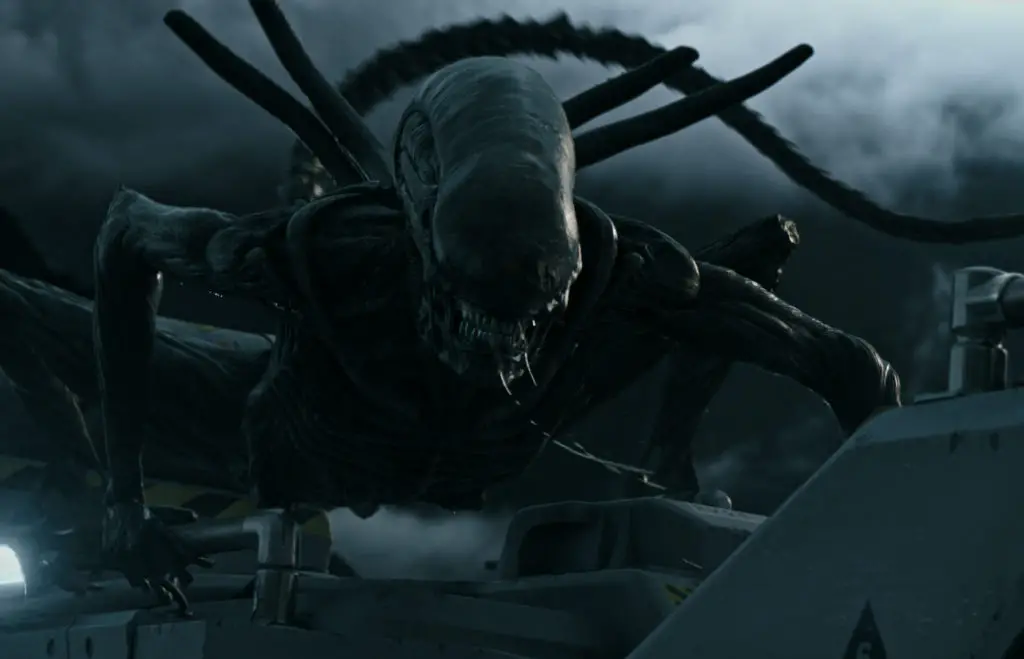 Frame from the film.
Frame from the film.Similar films
- “Black Hole” (USA, 1999): spaceship passengers crash-land on a planet where deadly creatures appear at nightfall;
- “Pandorum” (Germany, Great Britain, 2009): the crew of a starship wakes up after cryosleep and finds terrible warlike creatures on board;
- “Resident Evil” (USA, Germany, 2002): a special forces unit in a giant bunker encounters bloodthirsty victims of biological experiments;
- “Alive” (US, UK, 2017): an unknown life form terrorizes the crew of the space station;







